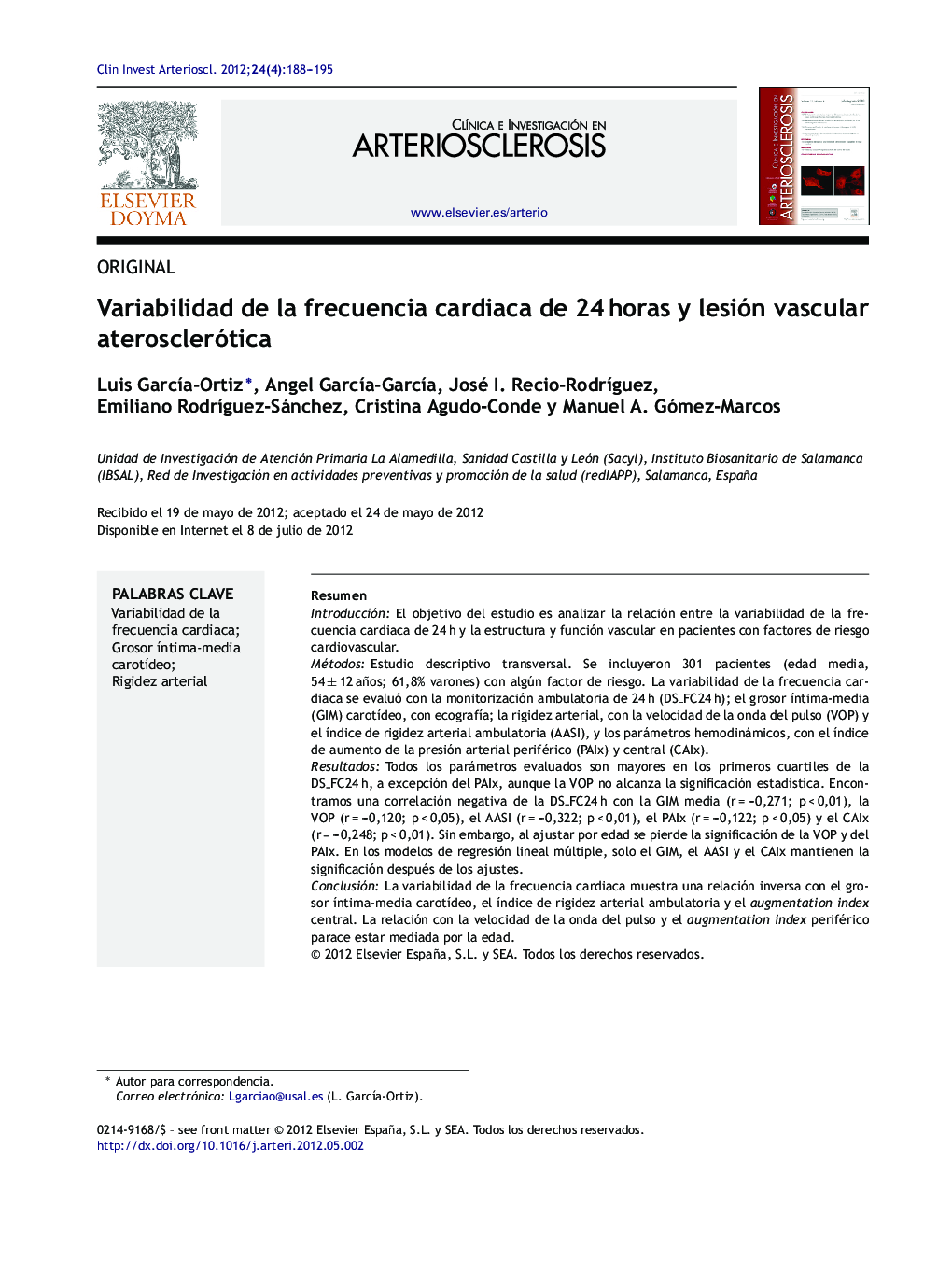| Article ID | Journal | Published Year | Pages | File Type |
|---|---|---|---|---|
| 2839842 | Clínica e Investigación en Arteriosclerosis | 2012 | 8 Pages |
ResumenIntroducciónEl objetivo del estudio es analizar la relación entre la variabilidad de la frecuencia cardiaca de 24 h y la estructura y función vascular en pacientes con factores de riesgo cardiovascular.MétodosEstudio descriptivo transversal. Se incluyeron 301 pacientes (edad media, 54 ± 12 años; 61,8% varones) con algún factor de riesgo. La variabilidad de la frecuencia cardiaca se evaluó con la monitorización ambulatoria de 24 h (DS_FC24 h); el grosor íntima-media (GIM) carotídeo, con ecografía; la rigidez arterial, con la velocidad de la onda del pulso (VOP) y el índice de rigidez arterial ambulatoria (AASI), y los parámetros hemodinámicos, con el índice de aumento de la presión arterial periférico (PAIx) y central (CAIx).ResultadosTodos los parámetros evaluados son mayores en los primeros cuartiles de la DS_FC24 h, a excepción del PAIx, aunque la VOP no alcanza la significación estadística. Encontramos una correlación negativa de la DS_FC24 h con la GIM media (r = –0,271; p < 0,01), la VOP (r = –0,120; p < 0,05), el AASI (r = –0,322; p < 0,01), el PAIx (r = –0,122; p < 0,05) y el CAIx (r = –0,248; p < 0,01). Sin embargo, al ajustar por edad se pierde la significación de la VOP y del PAIx. En los modelos de regresión lineal múltiple, solo el GIM, el AASI y el CAIx mantienen la significación después de los ajustes.ConclusiónLa variabilidad de la frecuencia cardiaca muestra una relación inversa con el grosor íntima-media carotídeo, el índice de rigidez arterial ambulatoria y el augmentation index central. La relación con la velocidad de la onda del pulso y el augmentation index periférico parace estar mediada por la edad.
IntroductionThe aim of this study is to analyse the relationship between the 24 hour heart rate variability and vascular structure and function in patients with cardiovascular risk factors.MethodsA descriptive, cross-sectional study was conducted on 301 patients (mean age 54 ± 12 years, 61.8% males) with any risk factor. The 24 hour heart rate variability (DS_FC24 h) was assessed using an outpatient monitoring device. The rest of the variables were the carotid intima-media thickness (CIMT), measured by ultrasound, arterial stiffness with pulse-wave velocity (PWV), the ambulatory arterial stiffness index, and the haemodynamic parameters with the peripheral arterial pressure (PAIx) and central arterial pressure (CAIx) index.ResultsAll the parameters evaluated were higher in the first quartiles of the DS_FC24 h, with the exception of the PAIx, although the PWV did not reach statistical significance. There was a negative correlation between the DS_FC24 h and the mean CIMT (r = –0.271; P < .01), the PWV (r = –0.120; P < .05), AASI (r = –0,322; P < .01), PAIx (r = –0,122; P < .05 and CAIx (r = –0,248; P < .01). However, on adjusting for age the significance of the PWV and PAIx was lost. In the multiple regression models, only the CIMT, AASI, and the CAIx remained significant after the adjustments.ConclusionThe heart rate variability shows an inverse relationship with carotid intima-media thisckness, the ambulatory arterial stiffness index, and central augmentation index. The relationship with the pulse wave velocity and the peripheral augmentation index appears to be associated with age.
